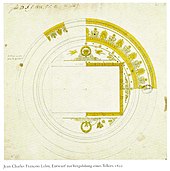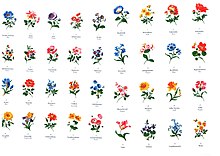Coloring template (porcelain painting)

Coloring used in porcelain painting to be able to repeatedly and accurately as possible motives nachmalen or printings. Porcelain painters learn to make coloring templates during their professional training.
Porcelain factories have archives with print graphics, copies of paintings, decor templates, etc., which are used as painting templates. So bought z. In the 19th century, for example, the Viennese porcelain manufactory offered numerous models. The archive of the Königliche Porzellan-Manufaktur Berlin has over 50,000 prints, draft drawings and studies and more than 6000 different images, photos and over 300 oil paintings.
Template creation
Decors
Templates for decors were made in the factories based on historical images from art history, such as B. foliage , banding , acanthus (ornament) , palmettes , meander (ornamentation) , shellwork ( rocaille ) etc. The coloring templates were designed by specialists for elaborate decors.
Botanical painting
Herbaria served as templates for the exact, lifelike representation on porcelain. They were mostly used by the porcelain painters to create their own coloring pages that were more suitable.
Flower painting
Flower painting reached its climax around 1750 with the so-called manner flower, when the aim was no longer to copy the original as precisely as possible, but instead moved the focus to the picturesque. The flowers, which were created in the hands of the Meissen manufactory painters, were always based on templates, e.g. B. a woodcut flower, an ombrated flower or a manner flower. The painters used to paint well-known templates from memory, without orienting themselves to the templates for every brushstroke.
Vedute painting
Print graphics were mainly used for vedute templates . Artists were also employed who were exclusively master painters. They were sometimes sent on study trips by the factories to create coloring pages of well-known landscapes, cityscapes and buildings, mainly castles and sights. Historical templates have been preserved. B. by Frédéric Frégevize , Johann Hubert Anton Forst and Carl Daniel Freydanck .
Portraits
Copies of paintings, drawings and prints serve as templates for portraits. After the invention of photography in 1839, photos were also used. These could also be transferred directly to porcelain (chromatography). A layer of chromate gelatin in which the porcelain paint (e.g. iridium oxide for black) was already embedded was used to transfer the image . In the muffle fire, the gelatine burned without residue.
Use in transfer printing
The process was developed in England and used in porcelain factories from 1810. The templates for the transfer printing process are reversed so that they appear the right way round after printing. They were engraved the right way round on copper or steel plates, then coated with refractory ceramic paints and melting agents, then transferred the wrong way round to specially prepared paper, applied to glazed porcelain and fired in a muffle fire. Sometimes the paper was left on the object to be printed, it then burned without residue in the subsequent muffle fire . The transferred outlines could then be painted in color. You could also print the porcelain colors on the transfer paper and use it to transfer decors onto the porcelain according to the decal principle . Since the quality was lower than with manual painting, this technique was abandoned after 15 years and only the outline transfer was used. Today you can use a computer and a special printer to print porcelain colors on the transfer paper and, in the case of flat porcelain plates, directly on the porcelain.
Berlin Cathedral (1747) , print by Friedrich August Calau (around 1820)
Exhibitions
There were three major art exhibitions in which painting templates for porcelain painting were presented: 1976 in Berlin on botanical painting, 1987 in Berlin on vedute by Carl Daniel Freydanck and 1993 in New York also on vedute by Carl Daniel Freydanck.
See also
Web links
Individual evidence
- ↑ MPorzMAusbV - Ordinance on vocational training to become a manufactory porcelain painter. Retrieved January 13, 2018 .
- ↑ Design drawings by the Vienna Porcelain Manufactory - MAK Museum Vienna. Retrieved February 5, 2018 .
- ↑ Hubert Winkler, Ilsebill Barta-Fliedl: Former court silver & table chamber: silver, bronzes, porcelain, glass . Böhlau Verlag Wien, 1996, ISBN 978-3-205-98323-1 ( google.de [accessed on January 13, 2018]).
- ^ Preussen.de - The KPM archive. (No longer available online.) Archived from the original on January 5, 2011 ; accessed on January 13, 2018 . Info: The archive link was inserted automatically and has not yet been checked. Please check the original and archive link according to the instructions and then remove this notice.
- ^ Samuel Wittwer : Refinement & Elegance. Early 19th century royal porcelain from the Twinight Collection New York. Hirmer Verlag, Munich 2007, ISBN 978-3-7774-3465-0 , p. 28, 31, 45, 71, 88, 179, 183, 211, 309, 350, 353, 356, 361,435 .
- ↑ Claudia Bodinek: templates for the Meissen flower painting. Retrieved January 14, 2018 .
- ^ Anke Fröhlich: Landscape painting in Saxony in the second half of the 18th century: landscape painter, draftsman and etcher in Dresden, Leipzig, Meissen and Görlitz from 1720 to 1800 . VDG, 2002, ISBN 978-3-89739-261-8 ( google.de [accessed on January 13, 2018]).
- ↑ https://www.kpm-berlin.com/manufaktur/porzellan-handwerskunst/ Chapter: POLIERGOLD, Paragraph 2: Text: The final firing for the onglaze painting is called a muffle fire (at approx. 860 ° Celsius). A separate room in the kiln protects the individual pieces from smoke and flames.
- ^ Catalog: Carl Daniel Freydanck, A vedute painter of the KPM . Nicolaische Verlagsbuchhandlung , Berlin 1987, ISBN 3-87584-210-3 , p. 28.
- ↑ Transfer printing process - The large art dictionary by PW Hartmann. Retrieved January 14, 2018 .
- ↑ Erich Köllmann / Magarete Jarchow: Berliner Porzellan , Volume I. Klinkhardt & Biermann, Munich 1987, ISBN 3-7814-0264-9 , p. 70. 6th paragraph
- ↑ Printing process with porcelain inks
- ↑ Winfried Baer H. Walter Lack: Plants on porcelain . Botanical Garden, Berlin 1979, ISBN 3-921800-13-7 .
- ^ Catalog: Carl Daniel Freydanck, A vedute painter of the KPM . Nicolaische Verlagsbuchhandlung , Berlin 1987, ISBN 3-87584-210-3 .
- ^ Derek E. Ostergard: Along the Royal Road 1993. , Library of Congress Catalog number = 93-079551




